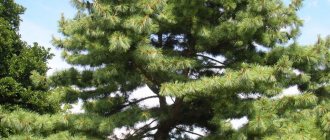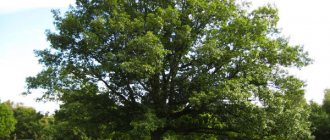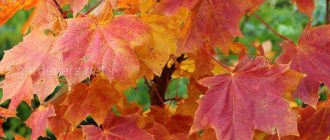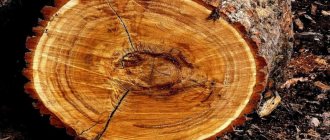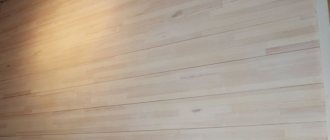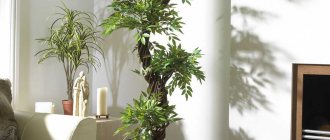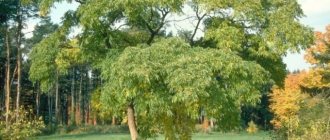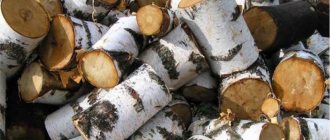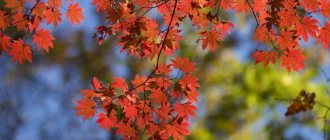Elm tree, description
The leaves are serrated from 2 to 16 cm, depending on the species. They have a characteristic asymmetrical base and taper towards the top. The leaves are arranged alternately on the shoots, forming a thick, dense crown.
Red-violet flowers, collected in inflorescences of several pieces, appear along the shoots in March or early April. After pollination, small winged fruits are formed in place of the flowers, which are carried by the wind.
Elm seeds that fall into the ground germinate literally in a few days, and the tree begins to bear fruit at the age of 6-7 years.
Garden varieties and types of elm with photos
Mountain elm or rough elm variety "Camperdownie" (Ulmus glabra Camperdownii ). It is a picturesque low tree with a characteristic weeping crown in the form of an umbrella of hard shoots.
The height of "Camperdownii" is usually 2 - 2.5 m. After a few years, the width of the crown can reach 6 - 18 m. The leaves are large, hard, and numerous. In autumn they acquire a golden yellow color.
Weeping elm "Pendula" with a compact crown. Another low-growing variety of mountain elm with shoots that form a green tent. Trees prefer sunny places and fertile soils.
The same type of variety from the Dutch (formerly "Monstros"). A rare dwarf elm, one of its smallest forms. Grows as a compact, round bush. At maturity, its size is only 40 cm in height and 40 cm in width.
The leaves are large, about 4 cm, which is special for this small plant. The unique appearance and shape of the variety fits perfectly into compositions of low-growing shrubs, coniferous crops and cereals.
Cork elm or elm (U. Minor) . Synonyms: small, field or hornbeam elm. In nature, it is a powerful, long-lived tree that grows throughout Europe. Three varieties have become widespread in horticulture.
"Argenteovariegata" . The decorative nature of elm lies in its variegated foliage with white and cream spots. It grows slowly. The height of an adult tree reaches 10 meters, and the width of the crown is 5 meters.
Typical requirements for this species are fertile, moderately moist soil, a sunny location, which enhances the brightness of the foliage color.
In the garden, “Argenteovariegata harmonizes well with other variegated plants, although such original varieties are usually planted separately to create a strong accent in the garden design.
"Webbiana" is an ornamental elm with a unique type of foliage. Throughout the season, the leaves of this tree are slightly curled. It seems that the tree is drying out or sick.
Meanwhile, this is a feature of the varietal form. Produces a wide crown of several large, strong branches. The maximum height is about 4-5 meters. It grows well in moist and fertile soil, but due to the structure of the foliage, which reduces water evaporation, the variety is resistant to prolonged drought.
The most popular and incredibly beautiful variety of this species is Jacqueline Hillier . Compact, low and slow growing tree. Its decoration is small, densely spaced, slightly curled, dark green leaves about 2-3 cm long.
Young leaves are pink. The varietal form is grown both on a standard and in the form of a bush. Can grow in any light. The variety is resistant to diseases and low temperatures, and can grow in fertile and poor soils. After 10 years, its height reaches 1.8 m.
White or American elm (Ulmus americana) . This tree is incredibly hardy; unlike many ornamental varieties and hybrids, it can withstand temperatures down to minus 42 °C! Unfortunately, this species is susceptible to Dutch disease.
Variety "Beebes-Weeping"
The tree has a high, slightly lacy crown. An interesting fact is that the American elm is not sensitive to photoperiod length - it will continue to grow throughout the fall, despite the shortening days, until its growth is stopped by frost.
7sotok.by
The content of the article:
1.Description of elm.
2.Types and varieties of elm.
3.Planting and caring for elms.
4. Diseases and pests of elm.
5. Useful properties of elm.
Massive mature elms with spreading crowns provide great shade. Under it you can hide from heavy rain and from the burning sun. This tree is a large tree, although in nature there are small varieties of it. This strong and powerful plant can reach 25 meters in height and 10 meters in crown diameter. Elm is a long-liver, its life expectancy under favorable conditions can reach three hundred years. The homeland of elm is considered to be European countries, Great Britain and Scandinavia, North America, as well as the Caucasus and the Crimean Peninsula.
Elm has several names - elm, birch bark, elm and elmovik. In total, sixteen species of this plant are known in the elm genus. An adult tree has a thick, straight trunk (up to one and a half meters in diameter) and a spreading crown with dense foliage. The leaves are large, regular symmetrical in shape, located on short petioles. It begins to bloom before the first leaves appear, from early March until April. Its flowers are small bunches of brown color with small stamens of a lilac hue. Already in May, the winged fruits ripen and are carried by the wind over long distances. Thanks to this, in different areas you can notice young elm shoots that have taken root as a result of self-seeding.
The tree has a powerful root system that often lies directly on the surface of a large area of land. Elm is a shade-tolerant plant, but it loves sunny areas and moist soil. The plant acquires its greatest strength and power when it settles on the coast of a reservoir. In conditions of high humidity it grows very quickly, up to about half a meter in height per year. With all this, elm will easily withstand any natural and weather changes - severe drought, prolonged heavy rains and floods, severe frosts (up to -50 degrees). It is definitely unpretentious and persistent, so it can grow on high hills, on endless plains and along rivers or lakes.
Types and Varieties.
English Elm (Ulmus procera Salisb).
This species has high frost resistance and winter hardiness. Favorable places for growth are considered to be deciduous and mixed forests, river valleys and moist soils on river banks. In such conditions, the elm can reach a height of about fifty meters. Its main feature is that it does not bloom.
Androsov's elm (Ulmus x androssowii Litv).
The species is hybrid. It is bred from varieties of bushy and stocky elm. The main task of the breeders was to develop a variety that would retain a powerful crown with dense vegetation and a relatively low height. This hybrid grows very quickly and is used for landscaping parks and alleys, and also as a hedge. This elm easily tolerates harsh winter conditions and summer dry periods. Propagated by seeds.
Smooth Elm (Ulmus laevis Pall).
Long-lived, can grow up to three hundred years. The tree prefers deciduous forests and rich, fertile and loose soils. It tolerates shadow well, forms and maintains the crown itself. Does not grow well on salty soils and in urban environments. Does not tolerate heavy dust and large amounts of exhaust gases. It can be found in parks and alleys.
Hornbeam elm (Ulmus carpinifolia Rupp. ex Suckow).
It is used as a decorative decoration in squares and parks, on personal plots and gardens. Prefers bright places and nutritious soils with strong moisture. The tree is winter-hardy and moisture-loving. Its huge spreading crown is especially beautiful during the flowering period with bright red flowers and bright yellow foliage in autumn.
Elm tree (Ulmus densa Litv).
Prefers wild Central Asian nature and easily copes with arid growing conditions. This species can be found in the southern regions of Russia as compositional natural decorations. The height of the tree reaches thirty meters, the crown is very dense and low.
Lobed elm (Ulmus laciniata Mayr).
This species grows in deciduous-coniferous forests in the Far East. An unpretentious, frost-resistant and shade-tolerant plant can be found both in the wild and in the city as a decoration and landscaping.
Elmovik (Ulmus pumila L).
This is a squat, low elm that can also grow in shrub form. Loves fertile and moist soils, but can adapt to different climate conditions and different types of soil. Ideal for decorating areas with arid climates, for street landscaping and for gardening construction.
Elm Akin (Japanese Birch Bark).
This fast-growing species reaches a height of about thirty-five meters. It has a very dense and wide crown. This versatile species is able to grow in frosty, low-light and urban conditions. Its luxurious crown is especially attractive in the autumn months. Propagated by seeds and suckers, suitable for decorative landscaping and construction.
Rough Elm (Ilm Mountain).
Can be found in mixed forests on calcareous soils. It has unusually large leaves (up to 17 cm in length). Its crown pleases with its flowering throughout the week. Elm is shade-tolerant and can grow in urban environments and cold climates. Prefers only highly moist soils.
Planting and Care.
The main method of propagating elms is by seeds and cuttings. Every gardener, regardless of the amount of experience, can easily root several cuttings at once. June and July are the most favorable times for this. In order for the cuttings to take root faster, daily abundant watering is necessary. Rooted cuttings or purchased young seedlings are planted in a shallow hole filled with fresh substrate. This will help the development and growth of the entire root system. In the first few days, young trees should be watered abundantly. And the tree trunk space must be covered with a ten-centimeter layer of wood shavings or peat.
When planting, do not forget to take into account that elm is a light-loving plant. And, if an adult tree can withstand the dense shadow of other trees, then a young tree in the shade may die. Choose a site for the elm in a well-lit area.
When planting seeds, you need to know that the high germination rate of elm seeds is only in the first week after they ripen. It is at this time that the seeds need to be planted. In the future, they will lose their qualities and will not live up to expectations. Seeds should be planted at a distance of 30 - 40 cm into the soil, with mineral fertilizers added to it. The first five to seven days require good watering. To retain moisture in the soil for a long time, you can cover the crops with film.
Crown formation can begin after the second year of life, and the first pruning is carried out in the fourth year. Before this, it is enough to remove dried and damaged branches.
Diseases and Pests.
The most dangerous for elms are Dutch disease (a disease of fungal origin) and white rot, but various leaf-eating pests and bark beetles can greatly harm the tree.
Dutch disease is most common in elms that grow in particularly wet soils. The causative agent of the disease is the bark beetle. First, there are fewer leaves on the branches, then mass wilting and drying of small branches begins. If prevention is not carried out in time, the tree will dry out completely in a very short time, in just a few weeks. The appearance of such a fungus in large forests can cause enormous damage to forestry.
In order to combat the spread of this fungus, it is necessary to cut down damaged plantings at the same time as uprooting the stump, since the disease can easily spread to other trees. It is advisable to use various chemicals to control pests. When individual branches dry out, it is necessary to trim them and spray the entire plant with a five percent solution of copper sulfate.
Beneficial features.
Elm is widely used for decorative landscaping and green construction in parks, squares, alleys and boulevards, and in home areas. Used in orchards as windbreaks. Thanks to its powerful root system, elm can be used to strengthen the soil on slopes, beams, ravines, and on the shores of reservoirs.
Elm leaves and bark are used as valuable raw materials. In official and folk medicine, elm seeds, flowers, leaves, branches and bark are widely used. Based on them, herbal decoctions, tinctures and medications are made that can have anti-inflammatory and antibacterial effects. Herbal infusions, which include elm, can help treat the genitourinary and digestive systems. They have an astringent and diuretic effect. Traditional medicine uses elm bark to treat various skin diseases - lichen, purulent rashes and ulcers, as well as to heal wounds.
Valuable and durable elm wood is used in furniture production. A very valuable property of elm wood is that it does not rot in water and tolerates any humidity. Various varieties of elm are popular in the work of landscape designers. Some varieties of elm are distinguished by their flexibility. Thanks to this property, in ancient times elm was used for the construction of ships, for the manufacture of shields and clubs, shafts and various kitchen utensils.
Elm branches and seeds are used as complete food for domestic animals. They contain a large amount of proteins, valuable fiber and other useful components. A flowering elm is a favorable place for bees. They collect pollen, sweet nectar and useful glue. The dense crown and dense foliage are able to trap dust and purify the air in urban environments.
General rules for caring for elm
Species belonging to the genus Ulmus tend to be more demanding when it comes to substrate and moisture levels. Their natural habitats are predominantly wet and fertile areas near rivers. However, the soil must be permeable, since elm does not tolerate stagnant water.
Young elm seedlings after planting require regular watering; the soil should not dry out. Mature trees are watered in the absence of rain and after a snowless winter.
Poor soils are enriched with compost or humus. The ground around the plantings is mulched with a thick layer of compost, bark or pebbles, which avoids moisture evaporation.
Elm care includes sanitary pruning, which is carried out in early spring. Since the shoots grow very slowly, severe shortening is not recommended.
Pests and diseases of elm
Elms were once one of the most popular trees in the European landscape. Unfortunately, in the twentieth century, many of them were affected by Dutch elm disease (DED).
The first symptoms of the disease are observed already at the turn of May and June, when at high temperatures the leaves begin to curl, fall off, and the stems dry out. This disease is quite aggressive, therefore preventive or therapeutic (at the onset of the disease) treatment with Topsin M 500 SC is necessary immediately after the temperature rises above 15 °C.
How to get rid of aphids using folk remedies - read here
The treatment is repeated after 10-14 days, trying to spray the preparation on all parts of the tree. The next treatment is repeated in the summer, and the last one is carried out in the fall. The Dutch hybrid is most susceptible to the disease; other ornamental elms are more resistant.
Split elm, lobed elm, split elm
Far East, Japan, China
deciduous montane forests
- up to 18 m;
- in Moscow at 35 years old - 9 m
wide-cylindrical, rounded at the top
from acidic to alkaline
rooting rate of cuttings – 20% when treated with Kornevin
at the beginning of fruiting, in autumn color
young branches are gray or yellowish
alternate, large, with apex elongated into a pointed point or with 3-5 (7) pointed lobes
Elm or Elm (Ulmus) in nature is a powerful tall tree or shrub. The genus of culture covers about 20 deciduous, rarely evergreen species, growing in temperate climate zones of North America, Europe and Asia.
In the garden landscape, only decorative elms are in demand, as they are easy to care for and have a long lifespan.
Smooth elm, common
Grows in Russia, the Caucasus, Western Siberia, Kazakhstan, Western Europe.
A tree with a wide, beautiful crown and hanging branches. Young shoots are light brown, fluffy, shiny. The bark is brownish brown. The foliage is round or oblong-ovate. The edges are sharp-serrated; dark green above; in autumn they turn brownish-purple. Brownish, small flowers with purple stamens. Flowering lasts about 10 days.
Shade-tolerant, winter-hardy. Growing quickly. It tolerates cutting well and retains its shape. Drought-resistant, grows only in fresh, deep soils. In urban conditions, on poor soils it grows poorly. Looks good in alley and row plantings.
Decorative forms : silver-variegated; golden-variegated; red - with reddish foliage; cut - with dissected foliage and notches between them. Decorative varieties are planted singly or in groups.
Areas where elm is used
Due to its outstanding qualities, elm is used in many sectors of the economy.
- Elm wood is characterized by high strength, resistance to high humidity, but at the same time it is easy to process and has a beautiful texture. It is often used in furniture making, shipbuilding and household utensils.
- Young tender shoots and seeds are used as livestock feed.
- The bark serves as a raw material for making paints.
- Widely used in medicine in the fight against diseases of the genitourinary system and gastrointestinal tract, the bark is used in the treatment of skin diseases.
- Elm plays an important role in beekeeping as a good honey plant.
- Elm is ideal for landscaping city streets due to its appearance and high adaptability.
| Ulmus lacinata Family |
Hornbeam elm
The homeland is the European part of Russia, Kazakhstan, the Caucasus, Western Europe, Central Asia, North Africa. Hornbeam elm grows in deciduous forests.
A tree with a dense crown and dark brown shoots. The foliage is dense, dark green, shiny, varied in shape, bare above and hairy below. In autumn it turns yellow. The flowers of the hornbeam elm are small, reddish-red. The elm blooms before the leaves bloom.
Winter-hardy in steppe and forest-steppe zones. Young shoots freeze over. Hornbeam elm is suitable for the southern regions of our country. The tree is undemanding to soil, but grows well only in moist, nutritious soil. It cuts well and holds its shape. Forms dense hedges. Used in parks and gardens, in masses or groups in combination with other breeds.
Meaning and Application
It is difficult to overestimate the importance of elm. Its bark, fruits and leaves are successfully used in folk medicinal recipes. It is important to talk to your healthcare professional before using elm in the treatment of various diseases. Therapy has side effects and contraindications.
Decoctions based on bark and leaves help reduce inflammation, have antibacterial properties, and help heal damage. The extract is used for the treatment of kidney, heart, blood vessels, thyroid gland, etc.
A decoction is useful for throat diseases. So, if you have a sore throat, it is recommended to gargle with it. Tea from the leaves is used for constipation. In case of hemorrhoids and kidney diseases, baths with elm bark are recommended. The tincture is used to get rid of skin rashes.
Elm wood is often used in industrial production due to its excellent properties. Elm wood is often used as an alternative to expensive wood species. Its texture allows you to imitate valuable varieties, with a fairly light color. Mahogany connoisseurs love elm. Elm is used to make furniture for the home and is also used to make paintings.
The density of elm wood is very high, approximately 600 kg/m3. The cut of wood has a beautiful texture, which makes it suitable for use in carpentry. It is resistant to rotting processes and is difficult to split and saw. However, it behaves very well when polished.
In the old days, elm was also used in carpentry workshops, and paint was made from its bark. Without taking into account the pests that attack the tree, it is often planted in parks, around the city, and in social institutions.
Small-leaved or squat elm
It grows in the wild in Transbaikalia, the southern and middle parts of the Far East, Japan and Korea. Small-leaved elm grows in mixed forests, on fertile soils.
Tree 15 m in height, or shrub with a rounded crown and thin branches. The leaves are small elliptical, leathery, unequal, with a short apex and a simply or serrated edge, smooth. In spring, the leaves of small-leaved elm are green. The flowers are collected in bunches. Lionfish are buffy or yellow-brown.
Small-leaved elm is light-loving and undemanding to soil richness. Drought-resistant, tolerates replanting, shaping, and pruning well. In terms of growth speed, the squat elm is not inferior to the ash-leaved maple and white acacia, it is more frost-resistant, and tolerates pruning and replanting well. This type of elm has no root shoots, and this is highly valued in park construction. Small-leaved elm has a weeping shape.
Brief information
Elm is a genus of trees in the Elm family. It also has other names: elm, birch bark, ilmovik or elm. There are more than 40 species of elms, most of them are found in the subzone of deciduous forests; closer to the south they can grow in spruce and coniferous forests.
They rarely grow alone; they prefer the vicinity of other trees; elm forests are also rare. On average they live 80-120 years, occasionally living up to 300-400 years. In the first few years they actively grow and develop; after 40-60 years, growth slows down and comes to naught.
Elms can reach 40 meters in height and 2 meters in diameter, and some species can grow as a bush.
The root system does not have a central root: some roots penetrate deep into the soil, the rest are located closer to the surface. On podzolic soils, the roots are close to the surface.
It is important to know:
Many species of elm are on the verge of extinction due to diseases and attacks by pests: leaf beetles, springtails, and fungi.
The leaves are 20 cm in size, have sharp, jagged edges, and are symmetrical. All leaves differ in shape and size, even if they originate from the same shoot - this is easy to see in photos or pictures.
Together they form a very dense crown through which the sun does not pass. Leaf growth begins only after fruit formation, and in the fall the elm is one of the first to lose its leaves.
The flowers are quite small and inconspicuous, growing and developing before the leaves appear. Occasionally, flowering may begin in the fall. The fruits ripen already in April-June (the further south the region, the faster). They are nuts with wings that are carried by the wind throughout the surrounding area.
When placed in moist soil, they begin to grow within a few days. Southern species bear fruit from 5-10 years, northern ones - after 20 years. In addition to seeds, they can reproduce by roots and shoots that appear on stumps.
The economic importance of the plant is quite high:
- The wood of the tree is extremely durable, resistant to dampness and does not splinter easily, but at the same time easily tolerates processing and has high aesthetic qualities. It is often used in furniture making, and was previously used to build ships, weapons and dishes.
- Young shoots and seeds are used to feed livestock.
- Paints are obtained from the bark.
- In medicine, elm is used to combat diseases of the genitourinary system and digestion, and the bark is used for skin diseases.
- Elm is an excellent honey plant loved by bees.
- Elm is often used for urban landscaping, since the crown does not require trimming and does an excellent job of purifying the air.
The plant easily tolerates many unfavorable conditions (drought, rain, severe frost), which makes it an extremely popular and sought-after tree in difficult urban environments. In the wild it chooses deciduous and coniferous forests, and is artificially grown within the city.
Rough elm
It grows under natural conditions in Russia, Central Europe, Scandinavia, and Asia Minor. There are many nature reserves in Russia, the Caucasus, Crimea, and the Baltic states. Rough elm grows in coniferous-deciduous forests, sometimes on calcareous soils.
A tree with a rounded, wide crown, reaching 35 m in height under optimal conditions. The bark on the trunk is brown, the branches are dark brown. The foliage of the slippery elm is large, sharp-toothed along the edges, rough above and coarsely hairy below, on short, pubescent petioles; yellowing in autumn. The flowers are collected in bunches. Flowering lasts 5-7 days. Quite large, green lionfish with a notch at the top, also in dense bunches.
Rough elm grows quickly. Frost-resistant. Tolerates urban conditions well. Drought resistant. Tolerates crown pruning well. Gas resistant. Rough elm propagates by seeds, and decorative forms of elm by grafting. A large tree suitable for single plantings in combination with maple and oak.
The best decorative varieties
Decorative varieties of birch bark are bred from wild species. The most popular is small-leaved elm. Its varieties are used in urban landscaping; the most common are:
- "Pendyla" - weeping crown shape with flexible young shoots;
- "Lutescens" - rounded crown shape, leaves from light green to dark yellow;
- "Fastigiata" - formed in the form of a column.
Among the low-growing representatives of the family, the mountain elm varieties “Campendula” and “Low” are distinguished by decorative characteristics. “Campendula” reaches a height of 4 m. The crown is rounded, with long hanging branches. “Low” birch bark grows up to 2 m. It grows slowly, has small openwork leaves.
"Jacqueline Hiller" is grown as a shrub or on a trunk. It reaches a height of 3–3.5 m, adapts equally well to shady and sunny places.
Elms do not tolerate pruning. They can only be trimmed a little. Therefore, each decorative representative has a certain crown shape at the genetic level. Therefore, it does not need to be formed. Most birch bark trees tolerate cold temperatures down to -30 °C, so they are grown in different regions of the world from North America to the shores of the southern seas.
The genus includes 16 species that grow in Europe, Asia, and the mountains of Asia.
As a rule, these are large trees with an elliptical or rounded, spreading crown; with alternate, simple, large, unequal leaves. The elm blooms before the leaves bloom. Elm flowers are small and inconspicuous. The fruits are nuts, ripening 2 weeks after flowering.
Elm does not tolerate shading, but it provides dense shade. Growth is relatively fast. It requires fertile soil to grow, but can also tolerate dry conditions.
Elm tolerates pruning well, is durable under good conditions, and is often damaged by diseases and pests. It has been used in landscaping for a long time. It has been cultivated since ancient times and has many garden forms.


